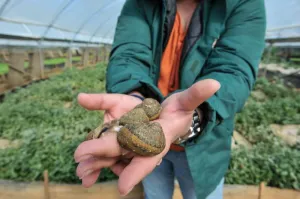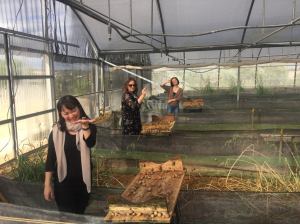Health benefits of snails
Snails are found everywhere and whilst most gardeners dislike them, here in Portugal instead of being a pest, snails are a culinary delicacy. June is the month when snails appear on menus and a new shop/restaurant has now opened near the Algarve Resident office, where you can enjoy a plate of snails for €2.50 or buy them to cook at home.
Although repulsive to many people, snails are consumed all over the world and are a very healthy thing to eat. Roasted snail shells found in archaeological excavations indicate humans have eaten them since prehistorical times and the Romans cultivated snails by feeding them special diets to improve their flavour.
The species Theba Pisana, Otala Lactea and Helix Aspersa are the most consumed. They possess anti-cancer properties and boost the immune system due to their antioxidants and anti-inflammatory effects.

An average snail is comprised of 80% water, 15% protein and 2.4% fat. They contain essential fatty acids, calcium, iron, selenium, magnesium and are a rich source of vitamins E, A, K and B12. However, despite these benefits I could not eat one!
If you plan to collect and cook your own snails, note some should be avoided due to the plants they eat (such as daisies) which makes them taste very bitter. It can take up to 10 days to clean the snails prior to using them in a recipe involving lots of oregano and garlic.
Although there is some farming of snails in Portugal (known as heliciculture or heliculture), most are imported from Morocco where they can be purchased alive at around €1 per kilo to be sold here for around €5.
The latest trend is for snails’ eggs ‘Pearls of Aphrodite’, known as white caviar, retailing at around £1,600 per kilo. Mostly ‘farmed’ in Spain, the eggs are laid twice a year, collected with tweezers, washed, purified and sterilised before being lightly salted and tinned – this explains their high cost.
Did you know that snails are also used for cosmetic and medicinal purposes?
The benefits of snail slime were recognised in ancient Greece by Hippocrates who used it to heal skin and ulcers and to reduce scarring. More recently, Chilean snail farmers highlighted the benefits when they noticed cuts on their hands healed very quickly and their skin became softer. This is because the slime contains allantoin, antibiotics, glycolic acid, collagen and elastin, and so it heals and regenerates skin cells minimising scars.
In 2013, Louis-Marie Guedon in France began to harvest snail slime (without harming the snails) and now plans to produce 15 tonnes a year to meet the increasing demand from cosmetic companies wishing to incorporate the slime in their skin care products.
In Tokyo, there is a spa where you pay to have snails slithering over your face, but personally I could not lie still with snails crawling over me no matter how rejuvenated it left my skin!
So how much do you know about the life of a snail?
Belonging to the mollusk family, sea snails lived 550 million years ago and land snails evolved 286 million years ago. There are now 43,000 snail species found in different habitats around the world. Their bodies have no bones and their shells are made of calcium carbonate with protein layers which harden over time.
Water snails have the most intricate patterns in red, orange and yellow whereas land snails use camouflage colours such as white, brown and grey to hide from their many predators.
Snails have a simple brain but are capable of associative learning and of forming long-term memories. They can lift up to 10 times their own body weight in a vertical position.
Did you know snails have over 14,000 teeth on their tongue, which is rough like a cat’s, and they can locate food a few metres away due to their extraordinary sense of smell? The larger set of tentacles is their eyes, although they are almost blind and the smaller set is their olfactory organs.

Snails are one of the slowest creatures on earth, moving along at 1.3cm a second. Mostly active at night or during the day if it rains, many species hibernate in winter or during severe droughts, by sealing their entrance with dried mucus called an epiphragm and then gluing themselves to something in a shady place.
The largest land snail recorded was a giant African snail measuring 12 inches long and weighing nearly two pounds. They only live for around five years although some species can live up to 25 years, (except around here as they are collected and cooked long before they grow up).
Snails are hermaphrodites so they have both male and female reproductive organs, but they still need another snail in order to fertilise each other’s eggs or they take it in turns which sex to be! Mating occurs at the end of spring into early summer and 80-100 eggs are laid in the soil.
Transparent baby snails hatch within two to four weeks and it takes up to three months for them to fully develop their adult colours. They are usually a mirror image of their parents and reach adult size and sexual maturity in two or three years.
Some snail species are considered as one of the most invasive species in the world, causing great damage to agriculture. Typically, most gardeners try to exterminate snails using chemicals, however, a recent study has indicated that if you remove a snail 20 metres away, they will not return and it is therefore more ecologically friendly to collect and take them to some waste land. So, throwing snails over the fence into your neighbours garden will not work as they will come back!
Want to know the life of snails?
Come and take a guided tour of a snail production and get a closer look at how they live and how they feed.Our farm creates and markets snails as well as “Helix Aspersa Máxima” fingerlings in an adapted complete biological cycle. All the production is carried out in an agricultural greenhouse with irrigation systems by nebulizers, in order to guarantee the ideal temperatura and humidity for the growth and development of the species. The greenhouse is composed of 12 fenced parks seeded with radishes, cabbages and turnips and with an average of 460 shelters in appropriate wood.
